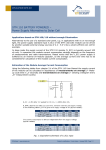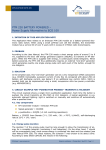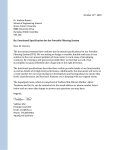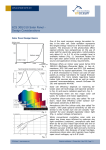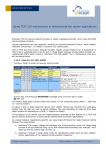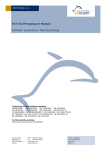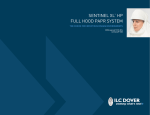Download AN209: STM 300 THERMO OR BATTERY POWERED
Transcript
APPLICATION NOTE 209 STM 300 THERMO OR BATTERY POWERED – Power Supply Alternatives to Solar Panel Applications based on STM 300(C) in environments without enough Illumination Alternatively to the use of a standard solar panel, e.g. in applications with no or not enough light, the STM 300/300C module can also be powered by another suitable external power sources like i.e. a thermo generator based on a standard Peltier (Seebeck) element and the EnOcean ECT 300 energy harvester or even a small low cost Li/MnO2 coin battery. Background: in sleep mode the supply current of the STM 300(C) module is typically 0.2 µA. In operation the current consumption strongly depends on the frequency of wake ups and radio transmissions, so the average current over time has to be considered for calculation of the module average current consumption, see Fig.1 below, more details see chapter 2.11 of the STM 300(C) User Manual. 100 10 Current [mA] 1 0.1 0.01 0.001 Sleep 0.0001 0.00001 0 10 20 30 40 50 60 70 80 90 100 Time [ms] Fig.1: Current Consumption of STM 300(C) Module Average Current Consumption and power source considerations Calculation Example: Cyclic measurement with transmission every 100 s. Using the table from chapter 2.11 of the STM 300(C) User Manual the required continuous supply current depending of Wake cycles and Transmit interval settings can be easily found. According the mentioned table (first, second and last column, see Table 1) a STM 300(C) needs a 1.6 µA continuous current to wake up every 100 seconds (Wake cycle=100) and transmit by every Wake (Transmit Interval=1): I_STM ≈ 1.6 µA © EnOcean | www.enocean.com Table 1 Wake cycle [s] 1 1 1 10 10 10 100 100 100 Transmit interval 1 10 100 1 10 100 1 10 100 Current required cont. operation (µA) 130.5 40.5 31.3 13.5 4.4 3.5 1.6 0.8 0.6 Subject to modifications | Christian Bach | Feb 2010 | Page 1/ 3 APPLICATION NOTE 209 STM 300 THERMO OR BATTERY POWERED – Power Supply Alternatives to Solar Panel Using a Battery as power supply: Even a small battery capacity of 0.150 Ah (a coin cell CR2032 has > 0.230 Ah) would theoretically mean about 10 years continuously function for this setting (150 mAh = 0.0016 mA x X h => X = 150 mAh/0.0016 mA = 93750 h = 3900 days). Bearing in mind that the energy of a battery cannot be fully drawn for this purpose (means only approx. 50% of its nominal capacity, until the voltage drops below about 2.2 Fig.2 V), a single CR2032 coin cell still allows more than 8 years of continuous function. In these 8 years the STM 300(C) can wake up and transmit more than 2.5 millions times. Please notice that in order to ensure the needed peak current capability of approx. 40 mA without damage, the coin cell battery must be buffered by an external low leakage capacitor (not on STM 300(C) included, see Fig.2.) For low cost applications standard manganese dioxide lithium 3 V coin battery can be used. Depending on the energy demand different capacity sizes can be chosen. Generally please consider the limited life time behavior of batteries, even if the energy balance calculation indicates a multiple year operation time. It also could be useful to have a control of the supply voltage to know in time when the battery voltage fails below a certain limit to be changed before failure. The circuitry described in the Application note AN309 can be used to do this. Using a Thermo generator (ECT 300 + Peltier element) as power supply (Fig.3): Considering again the Table 1 relation (same scenario, I_STM ≈ 1.6 µA) and considering a STM 300(C) supply voltage of 2.7 V results the long term averaged required power at the transmitter to send every 100 seconds: P=U x I: or P=2.6 Vx1.6 µA=4.4 µW. Fig.3 An ECT 300 based thermo generator would deliver this power by >2 K temperature difference as shown in Fig.4 (ECT 300 User Manual): The Peltier element output voltage, (12.5 mV/K) is in this case only 25 mV. Considering for the ECT 300 at this absolute lowest operational input voltage a conversion efficiency of 20%, about 22 µW of continuous input power (delivered by the Peltier element) are therefore required. The energy storage device C* (Fig.3) at the ECT 300 output has now two Fig.4 functions: it must store the continuous delivered low energy (i.e. 4,4 µWs) between two consecutive transmissions (i.e. for 100 seconds) and deliver the required peak currents. Please note in this case that at least 2K permanent temperature difference between the both sides of the Peltier element must be always available, otherwise the use of an appropiate energy storage management circuit is recommended, e.g. see STM 300(C) User Manual, §3.1. For more details about specific system performance and considerations regarding thermo generator dimensioning please consult the ECT 300 and EDK 300(C) user manuals. © EnOcean | www.enocean.com Subject to modifications | Christian Bach | Feb 2010 | Page 2/ 3 APPLICATION NOTE 209 STM 300 THERMO OR BATTERY POWERED – Power Supply Alternatives to Solar Panel Disclaimer The information provided in this document describes typical features of the EnOcean radio system and should not be misunderstood as specified operating characteristics. No liability is assumed for errors and / or omissions. We reserve the right to make changes without prior notice. For the latest documentation visit the EnOcean website at www.enocean.com. © EnOcean | www.enocean.com Subject to modifications | Christian Bach | Feb 2010 | Page 3/ 3



